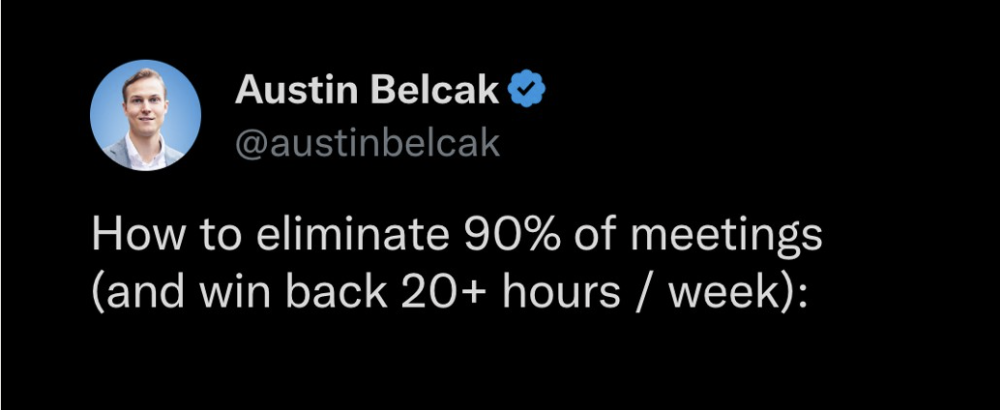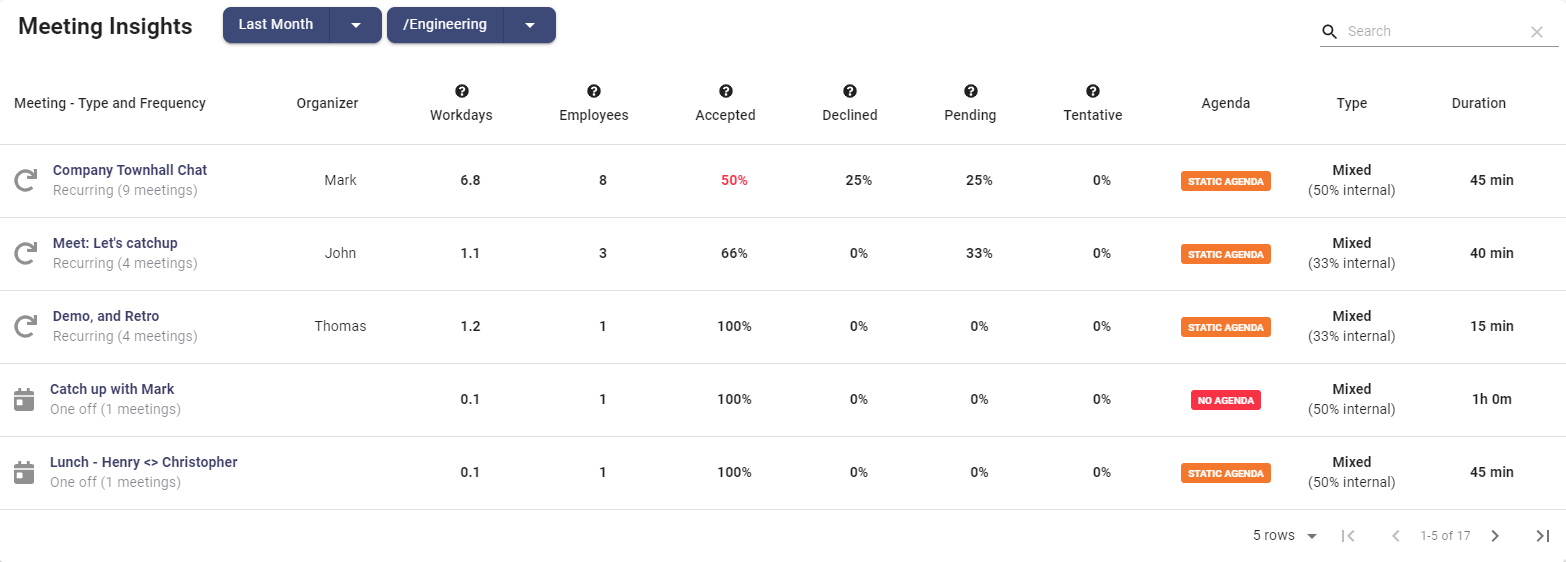Meetings are a cornerstone of our professional lives. They're the spaces where we collaborate, make decisions, and align our teams. But, there's a growing sentiment that we might be caught in a meeting overload, leaving us with scarce time for focused, uninterrupted work - the kind of work that truly drives progress.

A recent tweet thread by Austin Belcak (@austinbelcak) outlined a practical approach to significantly reduce meetings and enhance 'deep work' - a state of focused, distraction-free work where real productivity happens.

However, it's not just about reducing meetings, but about making them more effective. This post will explore Belcak's strategy and discuss how meeting analytics can help reclaim focus and boost deep work.
The Power of Deep Work
Deep work, as coined by productivity expert Cal Newport, is the ability to focus without distraction on a cognitively demanding task. It's a state of flow where you can produce high-quality work in less time. In an age of constant digital distractions and overflowing meeting calendars, finding time for deep work has become a significant challenge.
According to Belcak's post, the average employee is stuck in 5+ meetings per day, and meetings have risen by 70% over the past two years. This constant influx of meetings, coupled with the incessant notifications from Slack and email, can lead to a significant dip in productivity. The time spent in meetings is time taken away from focused, deep work - the kind of work that truly drives progress and innovation.
But it's not just about the quantity of meetings; it's also about their quality. An unproductive meeting can be just as detrimental to deep work as an excessive number of meetings. This is where we see meeting analytics can play a pivotal role. By providing insights into meeting habits and effectiveness, meeting analytics can help not only reduce unnecessary meetings but also enhance the productivity of those meetings.
A Strategy for Enhancing Deep Work
Belcak's post outlines a four-step strategy for reducing meetings and enhancing deep work. Let's break it down:
-
Categorize Meetings: The first step involves reviewing your past meetings and categorizing them into two buckets - mandatory/mission-critical meetings and those that could have been an email. This exercise can provide a clear picture of how much of your time is being spent on meetings that are truly necessary.
-
Create "Deep Work" Zones: The next step is to block off a 3-hour period every day for focused, deep work. This dedicated time slot can serve as a buffer against the constant barrage of meetings and distractions, allowing you to dive deep into your tasks.

-
Set Expectations: Informing your colleagues about your new schedule is crucial. By setting clear boundaries and communication channels for emergencies, you can ensure that your deep work time is respected and uninterrupted.
-
Offer Alternatives: When someone requests a meeting, offer alternatives like email, asynchronous video, or a short 15-minute meeting. This can help reduce the number of unnecessary meetings and ensure that the meetings you do hold are productive and efficient.
While this strategy provides a solid foundation for enhancing deep work, it can be further optimized with the use of meeting analytics. Another option is to take a direct approach and actually limit the number of meetings employees attend...
How To Reduce Time Spent in Meetings
Efficiently managing meeting time is crucial for fostering deep work and maintaining productivity. Meetings, while essential for collaboration and decision-making, often consume a significant portion of the workday. Here are some strategies to effectively reduce the time spent in meetings:
-
Set Clear Agendas: Every meeting should have a specific agenda outlining the topics to be discussed. This keeps discussions focused and prevents meetings from deviating off course or running longer than necessary.
-
Implement Time Limits: Establish strict start and end times for all meetings. Communicate these limits to participants and enforce them consistently to ensure meetings do not extend beyond the allocated time.
-
Prioritize Essential Meetings: Utilize meeting analytics to determine which meetings are truly necessary. Eliminate redundant meetings and combine others when possible to minimize the overall number of meetings.
-
Encourage Asynchronous Communication: Use tools like emails, project management software, and collaboration platforms for discussions that do not require real-time interaction. This reduces the need for frequent synchronous meetings.
-
Regularly Review Meeting Practices: Continuously analyze meeting data to identify trends and areas for improvement. Adjust meeting practices based on these insights to ensure they remain efficient and purposeful.
By adopting these strategies, organizations can significantly reduce the time spent in meetings, allowing more time for deep work. This approach not only boosts individual productivity but also enhances overall organizational efficiency, leading to better outcomes and a more engaged workforce.

The Role of Meeting Analytics
Meeting analytics is the process of collecting and analyzing data related to meetings to gain insights into meeting habits, effectiveness, and impact on productivity. It involves analyzing various aspects of meetings, such as their frequency, duration, participants, cost, and outcomes, among others.

With this understanding, we can see how meeting analytics can be a game-changer when it comes to enhancing deep work. By providing data-driven insights into our meeting habits, meeting analytics can help us make more informed decisions about how we spend our time. Let's explore how meeting analytics can supercharge the strategy outlined by Austin Belcak.
Categorizing Meetings
Let's take the first step of Belcak's strategy - categorizing meetings. With meeting analytics, this process can be automated and made more accurate. By analyzing the content and context of meetings, meeting analytics can help identify which meetings are truly mission-critical and which ones could have been an email. This can save you time and provide a more accurate picture of your meeting habits.

Creating Deep Work Zones
When it comes to creating "Deep Work" zones, meeting analytics can help identify the best times for these zones. By analyzing meeting patterns and productivity levels throughout the day, meeting analytics can suggest the optimal times for deep work.

Setting Expectations
Setting expectations and offering alternatives are crucial steps in Belcak's strategy. Here too, meeting analytics can play a role. By providing insights into the effectiveness of different communication channels, meeting analytics can help make data-driven decisions about when to use email, asynchronous video, or a short meeting.
In essence, meeting analytics can supercharge Belcak's strategy by providing data-driven insights and automating processes. But the benefits of meeting analytics don't stop there.
How Flowtrace Can Help
Flowtrace understands the importance of effective meetings and the value of deep work. The detailed meeting analytics provided can help you implement the strategy outlined by Belcak and take it a step further.
These meeting analytics provide insights into company meeting habits, helping to identify patterns of meeting overload and areas for improvement. It can automate the process of categorizing meetings, saving time and providing a more accurate picture of the meeting landscape.
Flowtrace can also help identify the optimal times for "Deep Work" zones. By analyzing meeting patterns and productivity levels throughout the day, Flowtrace can suggest the best times for focused, uninterrupted work.
Additionally, Flowtrace can provide insights into the effectiveness of your meetings. By analyzing factors like meeting duration, participation, and follow-up actions, Flowtrace can help you ensure that meetings are productive and efficient.
Flowtrace can not only help you reduce unnecessary meetings but also enhance the productivity of the meetings held. By leveraging meeting analytics, you can reclaim your focus, boost your deep work, and drive progress and innovation.
